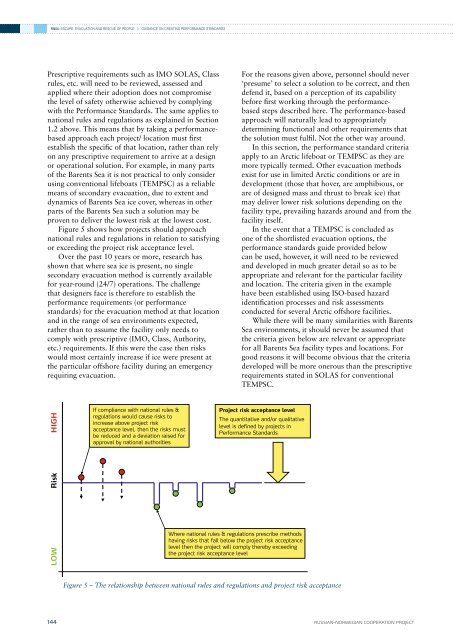phase 4 report - DNV
phase 4 report - DNV
phase 4 report - DNV
Create successful ePaper yourself
Turn your PDF publications into a flip-book with our unique Google optimized e-Paper software.
RN04: ESCAPE, EVACUATION AND RESCUE OF PEOPLE // Guidance on Creating Performance StandardsPrescriptive requirements such as IMO SOLAS, Classrules, etc. will need to be reviewed, assessed andapplied where their adoption does not compromisethe level of safety otherwise achieved by complyingwith the Performance Standards. The same applies tonational rules and regulations as explained in Section1.2 above. This means that by taking a performancebasedapproach each project/ location must firstestablish the specific of that location, rather than relyon any prescriptive requirement to arrive at a designor operational solution. For example, in many partsof the Barents Sea it is not practical to only considerusing conventional lifeboats (TEMPSC) as a reliablemeans of secondary evacuation, due to extent anddynamics of Barents Sea ice cover, whereas in otherparts of the Barents Sea such a solution may beproven to deliver the lowest risk at the lowest cost.Figure 5 shows how projects should approachnational rules and regulations in relation to satisfyingor exceeding the project risk acceptance level.Over the past 10 years or more, research hasshown that where sea ice is present, no singlesecondary evacuation method is currently availablefor year-round (24/7) operations. The challengethat designers face is therefore to establish theperformance requirements (or performancestandards) for the evacuation method at that locationand in the range of sea environments expected,rather than to assume the facility only needs tocomply with prescriptive (IMO, Class, Authority,etc.) requirements. If this were the case then riskswould most certainly increase if ice were present atthe particular offshore facility during an emergencyrequiring evacuation.For the reasons given above, personnel should never‘presume’ to select a solution to be correct, and thendefend it, based on a perception of its capabilitybefore first working through the performancebasedsteps described here. The performance-basedapproach will naturally lead to appropriatelydetermining functional and other requirements thatthe solution must fulfil. Not the other way around.In this section, the performance standard criteriaapply to an Arctic lifeboat or TEMPSC as they aremore typically termed. Other evacuation methodsexist for use in limited Arctic conditions or are indevelopment (those that hover, are amphibious, orare of designed mass and thrust to break ice) thatmay deliver lower risk solutions depending on thefacility type, prevailing hazards around and from thefacility itself.In the event that a TEMPSC is concluded asone of the shortlisted evacuation options, theperformance standards guide provided belowcan be used, however, it will need to be reviewedand developed in much greater detail so as to beappropriate and relevant for the particular facilityand location. The criteria given in the examplehave been established using ISO-based hazardidentification processes and risk assessmentsconducted for several Arctic offshore facilities.While there will be many similarities with BarentsSea environments, it should never be assumed thatthe criteria given below are relevant or appropriatefor all Barents Sea facility types and locations. Forgood reasons it will become obvious that the criteriadeveloped will be more onerous than the prescriptiverequirements stated in SOLAS for conventionalTEMPSC.LOW Risk HIGHIf compliance with national rules ®ulations would cause risks toincrease above project riskacceptance level, then the risks mustbe reduced and a deviation raised forapproval by national authoritiesProject risk acceptance levelThe quantitative and/or qualitativelevel is defined by projects inPerformance StandardsWhere national rules & regulations prescribe methodshaving risks that fall below the project risk acceptancelevel then the project will comply thereby exceedingthe project risk acceptance levelFigure 5 – The relationship between national rules and regulations and project risk acceptance144RUSSIAN–NORWEGIAN COOPERATION PROJECT






![Risk Based Pipeline Integrity Management [Compatibility Mode] - DNV](https://img.yumpu.com/50424229/1/190x146/risk-based-pipeline-integrity-management-compatibility-mode-dnv.jpg?quality=85)









